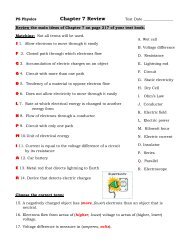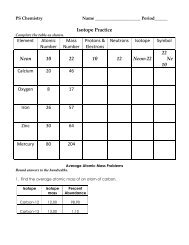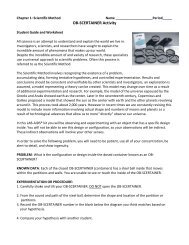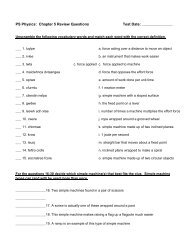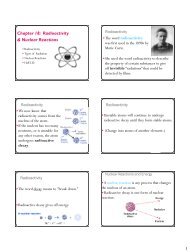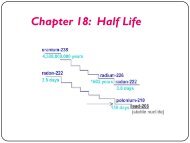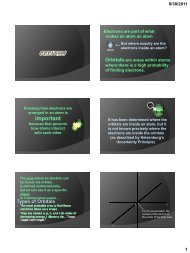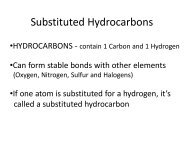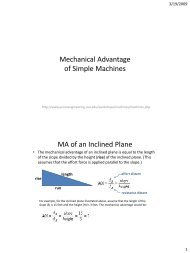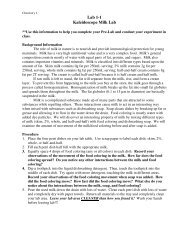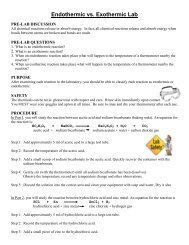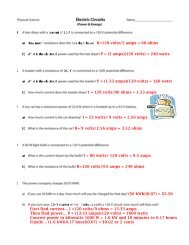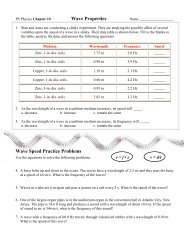Chapter 18 Vocabulary+
Chapter 18 Vocabulary+
Chapter 18 Vocabulary+
You also want an ePaper? Increase the reach of your titles
YUMPU automatically turns print PDFs into web optimized ePapers that Google loves.
<strong>Chapter</strong> <strong>18</strong> <strong>Vocabulary+</strong><br />
Radioactivity (pages 538-540)<br />
A. In most atoms, a strong force is able to keep the nucleus permanently together making the nucleus<br />
stable.<br />
1. When the force is not strong enough to hold the nucleus together, the nucleus can<br />
decay and give off energy.<br />
2. This process of nuclear decay is called radioactivity.<br />
B. Large nuclei tend to be unstable and can break apart.<br />
1. All nuclei that contain more than 83 protons are radioactive. Can other nuclei that contain<br />
fewer than 83 protons be radioactive? Yes<br />
2. Elements made in the laboratory are called synthetic. Are these elements stable? No<br />
Label the following<br />
mass number<br />
atomic number<br />
C<br />
C. What is the difference between carbon-12 and carbon-14 (beside the number 12 and 14)?<br />
carbon-12 has 6 neutrons and carbon-14 has 8 neutrons<br />
1. Carbon-12 and carbon-14 have the same number of protons in their nuclei; therefore,<br />
they are called isotopes.<br />
2. Which one, carbon-12 or carbon-14, is radioactive?<br />
carbon-14<br />
Radioactive Half-Life and Radioactive Dating (pages 544-545)<br />
A. If an element is radioactive, the nuclei will decay.<br />
14<br />
6<br />
element symbol<br />
1. The time required for half of the sample to decay is the half-life of that isotope.<br />
2. The nucleus left after the isotope decays is called the daughter nucleus.<br />
3. What is the half-life of<br />
a) hydrogen-3? 12.3 years<br />
b) iodine-131? 8.04 days<br />
c) polonium-211? 0.5 seconds
B. The radioactive isotope carbon-14 is used to estimate the ages of plant and animal remains.<br />
C. Uranium dating can be used to estimate the ages of rock.<br />
D. What is the percentage of radioactive nuclei left after 3 half-lives pass? (Hint: half of the sample<br />
decays at the end of each ‘half-life’.) 1/8 th = 12.5 %<br />
Measuring Radiation and Background Radiation (pages 548-550)<br />
A. What is the name of a device that measures amount of radiation? Geiger counter<br />
1. It produces an electric current when it detects a charged particle?<br />
2. The intensity of radiation present is determined by the number of clicks<br />
or flashes of light each second.<br />
B. Low-level radiation is emitted by naturally occurring radioactive isotopes found in Earth’s rocks, soil<br />
and atmosphere. Also traces of naturally occurring radioactive isotopes<br />
are found in food, water and air consumed by all animals and plants.<br />
C. The largest source of background radiation comes from the decay of radon gas. It is produced<br />
by in the Earth’s crust by the decay of uranium-238. This gas can seep into houses and<br />
especially basements from the surrounding soil and rocks.<br />
D. Radon gas exposure can lead to cancer. Do you have a radon reduction system in your home? I do.<br />
My home had high levels of radon gas when we purchased it in 2006. We had the sellers<br />
install the radon reduction system before we signed papers. (It would be in your<br />
basement-usually around a sump pump hole.)<br />
Radon gas levels are very high in Brookings County. If you have a basement, ask your parents if you<br />
have a radon reduction system in your home or have ever tested for radon gas levels in your basement.<br />
Nuclear Fission and Nuclear Fusion (pages 551-553)<br />
A. The process of splitting a nucleus is called<br />
fission. What does<br />
the word fission mean? “to divide”<br />
B. Only large nuclei, such as the nuclei of<br />
uranium and polonium,<br />
can undergo nuclear fission. A nuclear fission<br />
reaction creates a tremendous amount of energy
C. What is the equation that relates mass and energy?<br />
E = mc 2<br />
D. Small amounts of mass can be converted into an enormous amount of energy.<br />
1. For example, if one gram of mass can be converted into about 100 trillion J of energy.<br />
2. Splitting one uranium-235 nucleus can produce about 30 million times more energy than<br />
reacting one molecule of dynamite.<br />
E. Two nuclei with low masses are combined to form one nucleus of larger mass in a process called<br />
nuclear fusion.<br />
F. Fusion fuses atomic nuclei together whereas fission splits nuclei apart.<br />
G. The sun is mainly composed of hydrogen.<br />
1. The energy given off by the sun is created by the fusion of hydrogen<br />
nuclei into helium.<br />
2. As the sun ages, hydrogen nuclei are used up as they are<br />
converted into helium.<br />
3. Eventually, all of the hydrogen will be converted to helium, but not for another 5 billion years.<br />
<strong>Chapter</strong> <strong>18</strong> Concept Checks<br />
What is radioactivity?<br />
What is an isotope? Can you provide an example?<br />
What is half-life? Can you estimate the amount of sample left if you know the half-life of the isotope?<br />
What is radioactive dating?<br />
How does a Geiger counter work?<br />
What is background radiation?<br />
What is the difference between nuclear fission and nuclear fusion?



